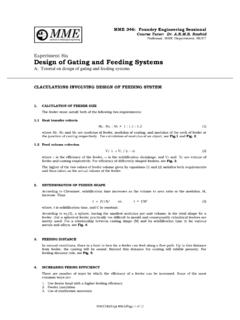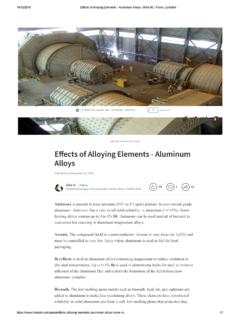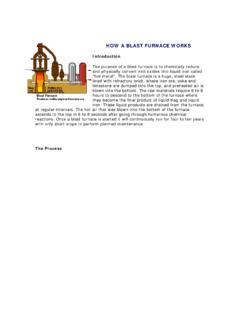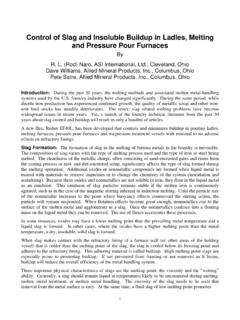Transcription of Pinholes - Foundry Gate
1 70 ExplanationsHydrogen and hydrogen-nitrogen pinholesThe formation of Pinholes progresses in several stages: 1. The surface reaction of water vapour with other elements in the iron gives rise to metal oxides and atomic hydrogen which diffuses into the molten metal. Similarly, nitrogen-hydrogen compounds dissociate on the hot metal surface and diffuse into the molten metal. Dissociation of molecular nitrogen and hydrogen does not take place at the prevailing casting temperatures. 2. Due to enrichments in the slag, the metal oxides react with the carbon in the melt to form CO molecules which are pre-cipitated from the melt and form micro-blowholes.
2 3. Hydrogen, and sometimes nitrogen, diffuse from the liquid metal into the CO micro-blowholes and increase their due to CO-slag reaction These occur due to the reaction of heavily oxidizing, molten slags (mostly MnO / MnS-rich slags) with the carbon in the melt to form CO. Later in the process, hydrogen can also diffuse into these porosity surface blowholesDifferentiation is made between hydrogen Pinholes , hydrogen-nitrogen Pinholes and Pinholes due to CO-slag features Pores or small blowholes with a smooth surface. Sub-surface blowholes often contain a thin graphite film. There is no differen-tiation between hydrogen and hydrogen-nitrogen due to CO-slag reaction also have smooth surfaces.
3 The size of sub-surface blowholes can vary considerably. Blow-holes occur in conjunction with oxygen-rich of the defect Pinholes can appear individually or over an area. All areas of the casting can be affected. However, Pinholes are more common in areas of the casting located away from the gate. Hydrogen and hydrogen-nitrogen Pinholes occur in both grey and SG iron castings. Pinholes due to CO-slag reaction only occur in grey iron for decisions P. 154 Sand control P. 18171 Description of defects: PinholesDescription of defects: PinholesFig. 32: Large areas of surface blowholes/ Pinholes on a grey iron casting.
4 Scale: 10 mm = 4 mm7273 RemediesMetallurgical Use charge components with low nitrogen content, reduce the quantity of steel scrap. Use scrap and return material free of rust, water and oil impurities. Use circulating materials free of impurities adhering to sand and feeder auxiliaries. Use charge materials and especially inoculants and circulat-ing materials with low aluminium and titanium contents. Deoxidize melts as well as possible. Avoid excessive supply of titanium or aluminium. Reduce the formation of slag, and particularly the formation of slags containing manganese sulphide, by adjusting the manganese and sulphur sand Reduce nitrogen content in the sand.
5 Reduce the quantity of inflowing nitrogen-containing core sand. If necessary, add new sand to the circulating sand. Reduce the moisture content of the sand. Lower the bentonite content. Improve development of the moulding sand. If necessary, reduce inert dust content. Keep amount of lustrous carbon carrier at the minimum level. With an oxidizing atmosphere in the mould cavity, if neces-sary increase the quantity of lustrous carbon producer in the moulding sand. Avoid adding too sand Reduce the amount of binder. Use binder with lower nitro-gen content. Improve core venting, dress core if necessary.
6 Add iron oxides to the core sand and pouring practice Increase pouring temperature Reduce flow rate into the mould Avoid turbulence when causesMetallurgicalFerrous metals Nitrogen content in the melt too high due to the charge com-position. Proportion of oxides, hydroxides (rust) and other impurities in the charge materials too high Aluminium content in the melt too high Manganese and sulphur contents in the melt too highClay-bonded sand Nitrogen content in the sand too high Moisture content of the sand too high Lustrous carbon production in the moulding sand too lowResin-bonded sand Nitrogen content in the core sand too high Proportion of nitrogen/hydrogen compounds in the core binder too high Gating and pouring practice Pouring passages too long Too much turbulence and slag formation during pouring Description of defects.
7 PinholesDescription of defects: PinholesFig. 33: Section through the surface of a grey iron casting in the area of pinhole formation. Pinhole formation is promoted by surface oxidation, recognizable in the formation of ferrite. Scale: 10 mm = mmAk ,0008,0006,0004,0002,0000 Surface tension [ N / cm]Aluminium content [%]No pinholesPinholesPinholesNo pinholes7475In the formation of CO bubbles, the surface tension of the melt is proportional to the work to be expended. According to Frenkel and Thompson, the intensity I of pinhole formation is described by the following equation: I = A eThe influence of surface tension on the formation of Pinholes has been investigated.
8 Higher surface tension suppresses pinhole tension at 1400 CFig. 35: Influence of aluminium content on surface tension and pinhole occurence in grey cast information A distinction is made between Pinholes caused by hydrogen, nitrogen-hydrogen and sub-surface blowholes due to slag / CO of pinhole formationBlowholes/ Pinholes arise in a melt under the following conditions:P = P0 + 2 r P Necessary gas pressure to form a blowhole P0 Atmospheric + metallostatic pressure s Surface tension of the melt r Radius of the blowholeCalculations of the gas pressure at which blowholes/ Pinholes can occur shows that the melt must be considerably over-saturated with gases such as nitrogen and / or hydrogen.
9 Sub-surface blowholes can form on solid reaction products in the melt at considerably lower gas pressures (phase boundaries). Similarly, where CO bubbles are formed through the reaction of oxides with the carbon in the melt, the dissolved gases (nitrogen, hydrogen) diffuse into the molecular gas pockets and form oxygen enrichment near the surface of the melt is necessary for the formation of CO bubbles. According to Gibbs, the formation of molecular CO blowholes is determined through the work to be expended:Ak = 43 r Description of defects: PinholesDescription of defects: PinholesFig. 34: Section through a surface pinhole in a grey iron casting, hydrogen-nitrogen defect recognizable by the graphite film and the partial decarburization of the surface zones.
10 Scale: 10 mm = ,0008,0006,0004,0002,0000 Surface tension [ N / cm]Total of additives present [%]S No pinholesS PinholesPinholesNo pinholesTelluriumTe No pinholesTe PinholesTi No pinholesTi defectsPinholes1350 C1280 C1200 CManganese [%]Sulphur [%] addition to pure CO Pinholes , molecular CO bubbles can be re-garded as the nucleus for hydrogen and hydrogen-nitrogen Pinholes Hydrogen is primarily introduced into a melt through the reac-tion of strong oxygen binding agents in the melt, aluminium, magnesium and titanium, with water + H2O MeO + 2 HThe atomic hydrogen is immediately absorbed by the melt.












